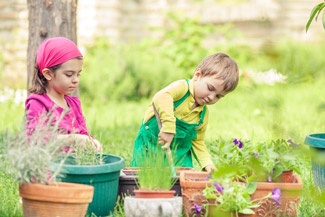Do green spaces promote cognitive development?
 While green spaces reduce exposure to urban pollution (atmospheric, visual and sound), we know far less about the positive role they can play in brain development. A recent longitudinal study evaluated the attentional skills of Spanish children ages 4-5 and 7 years who had always lived near green spaces. Does living near greenery improve attention?
While green spaces reduce exposure to urban pollution (atmospheric, visual and sound), we know far less about the positive role they can play in brain development. A recent longitudinal study evaluated the attentional skills of Spanish children ages 4-5 and 7 years who had always lived near green spaces. Does living near greenery improve attention?Until now, there was limited evidence of the virtues of long-term exposure to green spaces on cognitive development, often due to a failure to integrate prenatal and postnatal exposure into the assessment. To correct this, the present study was part of a longitudinal perspective based on data from two well-established birth cohorts, part of the INMA (INfancia y Medio Ambiente, Childhood and Environment), in Spain. The researchers were able to evaluate the impact of a green living spaces (visited since birth) on the attentional skills of preschoolers (n = 1044). The study, published in Environment Health Perspectives, is based on this data, collected from 2003-2013.
Two measures were used to estimate the degree of surrounding greenery: the normalized difference vegetation index, NDVI (including all types of vegetation) and the vegetation continuous field index (indicator of the canopy). For each participant, estimations of the surrounding greenery and tree cover were carried out by zone (immediate, intermediate and neighboring) around their home. To evaluate attentional abilities, two types of computerized tests were used: the Kiddie Continuous Performance Test (K-CPT) at 4 years (Sabadell cohort) and 5 years (Valence cohort), and the Attentional Network Task (ANT) at 7 years for both cohorts. In the first test, the subject must press the space bar when they see an image on the screen unless it's a ball. In the second, the child must press the left or right button of the mouse depending on whether a fish located in the middle of a horizontal row of 5 fish points to the left or the right. The researchers accounted for omission errors, commission errors, and hit reaction time-standard errors.
The results show that growing up in a green setting (NDVI index) from birth is associated with fewer omission errors (K-CPT) and time-out errors in 4-5 year olds (confirmed again, for the second measure, at 7 years). However, no relationship was found with commission errors (for both tests) and omission errors (ANT). Similarly, the links between tree cover (VCF index) and the different types of errors were not statistically significant.
This research indicates that children that enjoy green spaces around their homes perform better on attentional tasks. According to P. Dadvand, even if the relationships with the VCF index aren‘t conclusive, they still “underline the importance of green areas in cities for children's health and brain development.”
Source: Payam Dadvand, Christina Tischer, Marisa Estarlich, Sabrina Llop, Albert Dalmau-Bueno, Monica López-Vicente, Antònia Valentín, Carmen de Keijzer, Ana Fernández-Somoano, Nerea Lertxundi, Cristina Rodriguez-Dehli, Mireia Gascon, Monica Guxens, Daniela Zugna , Xavier Basagaña, Mark J. Nieuwenhuijsen, Jésus Ibarluzea, Ferran Ballester, Jordi Sunyer, “Lifelong Residential Exposure to Green Space and Attention : A Population-based Prospective Study”, in Environmental Health Perspectives , vol. 125, Sept. 2017







